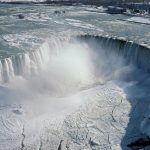
Sydney, known for its temperate ocean temperatures that rarely dip below 15°C, is witnessing a surge in ice swimming enthusiasts who embrace the frigid waters as a challenge and a thrill.
Wyatt Song, a former Bondi lifesaver, has been at the forefront of this unconventional sport. He made history as the first Australian to complete an ice mile, swimming 1.6km in 4.5°C near Falls Creek in Victoria. His passion has led him to plunge into Antarctic waters at 0°C and conquer two more ice miles.
To achieve this feat, swimmers must navigate 1.6km unassisted in water at 5°C or lower while wearing a standard bathing suit, goggles, and a silicone cap, adhering to the International Ice Swimming Association’s guidelines.
Song has now become a mentor, guiding aspiring ice mile swimmers at Wentworth Falls Lake in the New South Wales Blue Mountains, just 95km from Sydney. This location is particularly suitable for ice swimming due to its altitude, allowing water temperatures to drop to a bone-chilling 5°C or even 6°C during the winter months.
The ice mile journey involves more than just braving the icy waters; it’s about preparing the body for the physiological challenges that follow. Ice swimmers experience vasoconstriction upon entering the water, which reduces circulation to the extremities, followed by a drop in core body temperature and the onset of hypothermia. Once out of the water, the body undergoes the “after drop,” causing body temperature to plummet further, often triggering violent shivering. However, after an hour or so, swimmers typically stabilize, experiencing an energizing rush.
Song describes ice swimming as having an addictive quality, as it forces individuals into a survival mode that leads to an exceptional level of focus and body awareness. It becomes a journey of self-discovery.
Ram Barkai, the founder of the International Ice Swimming Association, embarked on his cold-water journey in Cape Town, South Africa, where the Atlantic Ocean regularly dips to 12°C. He later swam in 0°C Antarctic waters, setting records and inspiring others to explore the world of ice swimming.
Barkai emphasizes the mental aspect of ice swimming, explaining that the frigid waters slow down the body and require swimmers to relax despite the extreme conditions. He describes his mind as being “empty and completely focused” when in the ice, likening it to a laser beam.
Ice swimming has been gaining popularity globally, with 528 people having swum an ice mile, a fifth of them in the last year alone. The sport even made an appearance as a demonstration event at the 2014 Sochi Olympics, with aspirations for permanent inclusion in future Olympic Games.
While Barkai acknowledges the sport’s challenges and acknowledges the element of madness in it, he believes it appeals to individuals who seek to push their limits and discover the extraordinary within themselves. As he prepares to lead groups of swimmers to northern Mongolia and Antarctica, Barkai remains amazed at the sport’s growing popularity and the ordinary people who find something extraordinary within themselves through ice swimming.










Leave a Reply